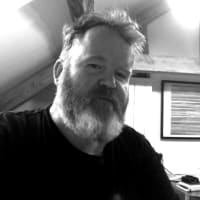
Gustav Metzger was a young Jewish refugee with Polish family background from Nuremberg, Germany. He came to this country just as WWII broke out in 1939. After the war his refugee status lapsed and he became 'stateless'. Metzger decided to stay in England while he studied art at the Academy in Antwerp between 1948-49.
Following his formal training in Belgium, Metzger began his development as an artist. Beginning with works on canvas, he eventually adopted more industrial materials which moved him on into a performative approach. He took up what we would recognise now as an activist outlook. He focused on anti-nuclear proliferation and environmental protection.
In the late 1950s, he was among the group of artists who coalesced initially in the art movement Fluxus. He pursued a more radical approache destroying his sub-straights for image-making using a term of his own devising: 'Auto-Destructive Art'. He and fellow artists like John Sharkey, questioned the idea of art being object-based, like some of those involved in Fluxus. They acted upon the hypothesis that artists did not need to be involved in the making of more stuff. They realised they could make art by producing posters, pamphlets, performances, and installations, all of which took the initiative away from galleries and museums, and put production and access to public appreciation under the control of the artist. Art went from their studio straight out into the world.
Here, however, is where Metzger and Sharkey differed from the larger group. They thought it more relevant to embark on a creative practice that reversed this process, by destroying the art object and subverting the conventions of cultural production. While the innovative direction of travel was similar, Fluxus had a broader area of interest and over time developed an international appeal through their more eye-catching events and publications, eventually attracting a second wave of artists like Joseph Beuys and Yoko Ono.
Unfortunately for Metzger his approach attracted relatively few acolytes and although his work employed in anti-nuclear campaigning and the early conservation movement was prescient, his use of quite harmful substances like acid, ensured he cut a much more singular path. This remained until he gained public appreciation for his political foresight during the 1970s and 80s.
Toward the end of his life in 2015, Metzger initiated the Remember Nature project which invited all artists to address the crisis within nature. He intended to bring awareness to the damages that continue to devastate our natural world. Remember Nature was organised by Metzger and curators to be a designated day of action.
A Worldwide Call By Artist Gustav Metzger To Remember Nature
Students from Central Saint Martins respond to Gustav Metzger's worldwide call for a Day of Action to Remember Nature at Central St Martins on November 4, 2015 in London, England. (Photo © Tristan Fewings/Getty Images for Serpentine Galleries)
At a launch event that took place at Central Saint Martins College of Art and Design and at art schools nationwide on the day, Metzger said:
“The art, architecture and design world needs to take a stand against the ongoing erasure of species – even where there is little chance of ultimate success. It is our privilege and our duty to be at the forefront of the struggle. There is no choice but to follow the path of ethics into aesthetics. We live in societies suffocating in waste. Our task is to remind people of the richness and complexity in nature; to protect nature as far as we can and by doing so art will enter new territories that are inherently creative.” Gustav Metzger, 4 November, 2015.
The 'Remember Nature' event was presented in numerous galleries and museums and artist groups across the UK.
To celebrate Remember Nature, GroundWork Gallery invite all to join a discussion about the current climate in connection with the current exhibition, Fluid Earth. In which seventeen artists explore the often uncomfortable fluidity of the earth’s environment, along with our attitudes and identities.
The tour of Fluid Earth will be followed by a visit and drinks reception at Woolmarket House, five minutes away on foot to see the fifteenth century building which served as Metzger’s studio whilst he lived in King’s Lynn.
This will be hosted by Paul Barratt and Paul Vater who run Contemporary and Country (C&C), now established in Woolmarket House. Metzger's former home now houses C&C's viewing room which has an ongoing programme of contemporary and applied art.
MORE ABOUT THIS EVENT ON EVENTBRITE
The Remember Metzger event coincides with C&C's opening of a new two person exhibition of North Sea Studies by Peter Wylie and recent shell work by Carolyn Brookes-Davies at Woolmarket House.




